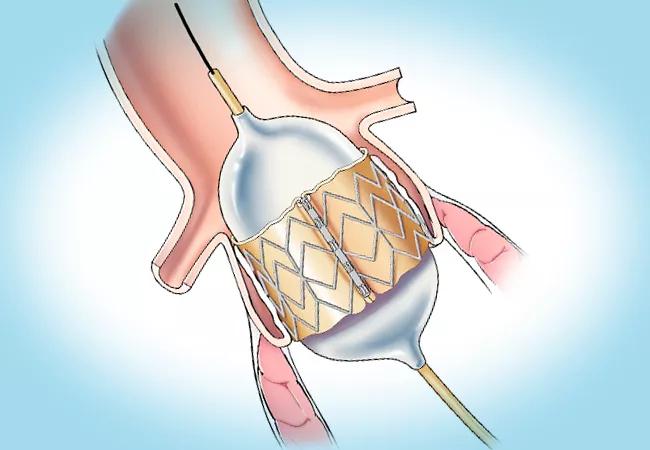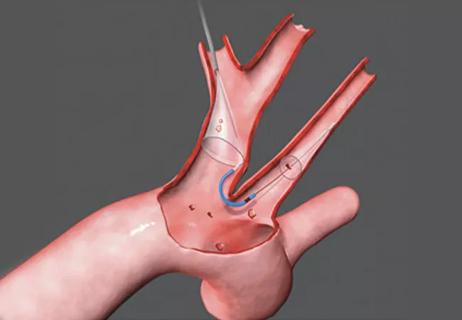Choice between smaller or larger prosthesis is a tradeoff between leak and pacemaker risks

In preparation for transcatheter aortic valve replacement (TAVR), the choice of valve size is one of the most important decisions a heart team has to make. The decision is generally straightforward when a patient’s aortic annular size matches that of a prosthesis. But when the annular size falls in the zone between two prosthesis sizes, there are two options: implant a smaller valve and overexpand it, or implant a larger valve and not fully expand it.
Advertisement
Cleveland Clinic is a non-profit academic medical center. Advertising on our site helps support our mission. We do not endorse non-Cleveland Clinic products or services. Policy
A Cleveland Clinic study, the first of its kind, has shed light on outcomes of both strategies in patients with a borderline-size annulus. The results are reassuring.
“We found that having a borderline annulus size did not significantly affect rates of mortality or major adverse cardiac or cerebrovascular events (MACCE) after TAVR, compared with having a non-borderline annulus size,” says Nikolaos Spilias, MD, a Cleveland Clinic interventional cardiology fellow and study co-investigator. “However, the choice of valve size affected the rates of permanent pacemaker implantation or paravalvular leak.” “There are no other data like this to help physicians make the right choice,” adds senior author Samir Kapadia, MD, Chair of Cardiovascular Medicine at Cleveland Clinic. “This novel set of data should give operators the information they need to make an informed decision between a larger or smaller valve based on a patient’s individual risks and considerations, knowing both can be safe and the tradeoff is between more risk of a leak versus more risk of a pacemaker.”
The study, presented at the American College of Cardiology’s annual scientific session, was a retrospective review of 1,816 patients who underwent transfemoral TAVR with the balloon-expandable Sapien 3 or 3 Ultra valves at Cleveland Clinic between 2016 and 2020. The patients were divided into borderline (n = 310; 17%) and non-borderline (n = 1,506; 83%) groups based on aortic annular area relative to the Sapien sizing chart.
Advertisement
At median follow-up of 23.4 months, there were no significant differences between the borderline and non-borderline groups in terms of mortality (17.3% vs 19.5%; P = 0.39), MACCE or stroke (21.2% vs 21.5%; P = 0.85) or paravalvular leak (21.8% vs 20.6%; P = 0.69).
When the patients with a borderline annular size were divided into subgroups according to whether they received a larger valve that was underexpanded (n = 113) or a smaller valve that was overexpanded (n = 197), again no significant differences in MACCE or mortality were seen.
However, the group that underwent the larger valve strategy had a higher rate of permanent pacemaker implantation (15.9% vs. 2.6%; P < 0.001). “The larger valve strategy appears to be associated with a higher pacemaker risk, which suggests a greater risk of compression injury to the conduction system caused by the valve frame,” Dr. Spilias notes.
Among patients receiving a smaller valve that was overexpanded, a trend toward greater risk of mild paravalvular leak was noted compared with patients receiving an underexpanded larger valve (25.9% vs. 13.3%), but the difference did not reach statistical significance (P = 0.12). “If you put in a smaller valve and overexpand, you may get imperfect sealing,” Dr. Kapadia explains.
When choosing a valve size for borderline-size annuli, the Cleveland Clinic researchers recommend a holistic approach to individualizing the choice for each patient instead of basing the decision solely on the sizing chart supplied by the valve manufacturer.
Advertisement
“Take into account the aortic annular area and other anatomic parameters of the aortic root, but do not rely on this alone,” Dr. Spilias advises. “Consider other parameters, such as the amount of calcium in the annulus, preexisting conduction issues and body surface area. For example, higher burden of calcium or conduction disease favors the choice of a smaller valve, whereas patients with a larger, taller body size may need a bigger valve than smaller patients do.”
Up to 85% of TAVR patients at Cleveland Clinic receive a Sapien balloon-expandable valve. Whether the findings from this study will apply to patients with borderline annulus sizes among the 15% of TAVR patients who receive a self-expanding valve is still unknown.
“The way we size self-expanding valves is the same, but we haven’t studied the concept to prove it,” says Dr. Spilias. “It would be logical to do the same study on self-expanding valves next and see what the outcomes have been.”
Advertisement
Advertisement

Patient series and bench validation support efficacy and safety of CLEVE procedure

Experience and strength in both SAVR and TAVR make for the best patient options and outcomes

Age and other factors figure into the choice among SAVR, TAVR, Ross, Ozaki and more

Optimally timed valve replacement depends on an expert approach to nuanced presentations

In the wake of NOTION-3 findings, a strong argument for physician judgment remains

Post hoc analysis of PROTECTED TAVR finds reduced stroke risk in the U.S. but not beyond

Aortic valve replacement is best option for lowering mortality in this high-risk population

Large longitudinal study supports earlier intervention over clinical surveillance